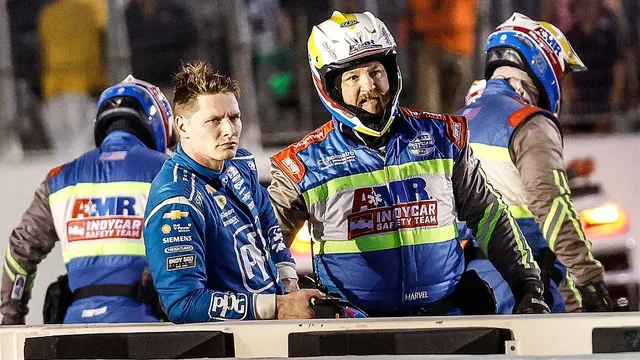
Josef Newgarden survives terrifying car flip in IndyCar race
2025-06-16 07:44- Josef Newgarden's car flipped during the Bommarito Automotive Group 500 IndyCar race after colliding with Louis Foster, who lost control of his vehicle.
- Both drivers were unharmed as they received immediate medical attention from the IndyCar safety crew.
- The crash raised awareness about driver safety in IndyCar racing, continuing discussions on the importance of safety measures.
Express your sentiment!
Insights
In Madison, Illinois, just outside St. Louis, a serious incident occurred during the Bommarito Automotive Group 500 IndyCar race. Josef Newgarden and Louis Foster collided mid-race, which resulted in Newgarden's car flipping over and skidding on its roof. The incident took place when Foster lost control of his vehicle, causing him to hit the wall. Newgarden, driving behind Foster, had little time to react and made contact with Foster's spinning car, leading to the dramatic crash. Both drivers were thankfully unharmed after the wreck. The crash raised significant concerns regarding driver safety. Immediate attention from the IndyCar safety team reassured fans and fellow drivers alike as they quickly assessed the situation. Newgarden was able to radio his Team Penske crew and confirm he was uninjured despite the severity of the incident. Following the event, the safety team flipped Newgarden's car back onto its wheels, and the race continued under yellow flags for cleanup. Before this incident, Will Power, another teammate of Newgarden, had experienced his own unfortunate crash earlier in the race due to a cut tire. This left Team Penske searching for their first win of the season as they faced a challenging race with multiple setbacks. Kyle Kirkwood ultimately won the race, marking his second consecutive victory this season amid a season where only he and Alex Palou have claimed race wins thus far. The impact of the crash on the race outcome and the implications for Team Penske were significant. Both Newgarden and Foster's standings in the season were affected, with Newgarden currently positioned in 16th place and Foster in 24th. Foster later commented on the crash, emphasizing his relief that both drivers emerged safely. Despite the high risks associated with motorsport, the effective response from safety crews highlighted the ongoing advancements in safety measures within the sport, ensuring that such incidents do not result in severe injuries or worse outcomes for the drivers involved.
Contexts
IndyCar racing, a thrilling and high-speed motorsport, has long been scrutinized for its safety measures, particularly given the high risks involved. The nature of the sport, characterized by extreme speeds and close competition, poses significant dangers to drivers. In recent years, however, the IndyCar Series has made tremendous strides in mitigating risks and enhancing driver safety through various innovations and regulations. These measures aim not only to protect drivers during races but also to ensure a safer environment in the pits and during the overall event operations. One of the critical advancements in driver safety has been the introduction of the Advanced Frontal Protection (AFP) system, designed to reduce the likelihood of head injuries during impacts. This device serves as a safety barrier between the driver’s head and the components of the car, significantly lowering risks during collisions. The cockpit has also been redesigned to enhance driver safety, incorporating stronger materials and more effective crash structures. These measures, alongside the use of modern helmet technology that includes advanced foam and shielding methods, contribute to a more secure environment for competitors. In addition to equipment innovations, the IndyCar Series has implemented stringent regulations concerning track design, pit safety, and race protocols. All tracks must meet specific safety standards, including the installation of SAFER barriers in critical areas to absorb impact during crashes. Pit lanes and crew areas are also subject to rigorous safety guidelines, ensuring more structured operations during pit stops and minimizing the chances of accidents. Furthermore, the series continually reviews and adjusts these regulations based on feedback from drivers, medical personnel, and safety experts. This iterative approach underscores the commitment to prioritizing the well-being of all participants. Medical response times and capabilities have been significantly improved as well. The presence of highly trained medical personnel at race venues has become a critical aspect of the safety framework. Each event is equipped with an emergency response team ready to address any potential injuries swiftly. Communication and coordination between track officials and medical teams are paramount, allowing for rapid responses in emergencies. As research continues to evolve, the IndyCar Series is likely to adopt even more sophisticated safety technologies and protocols in the future. This ongoing commitment to driver safety not only protects competitors but also fosters a culture of responsibility and care within the sport, ensuring that the thrill of racing comes with a focus on preserving life and health.